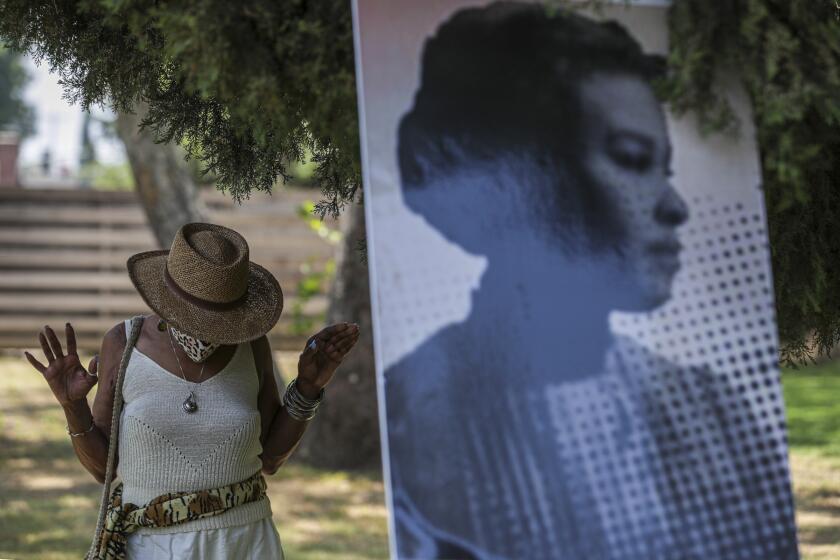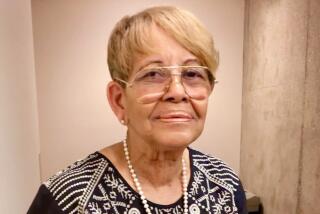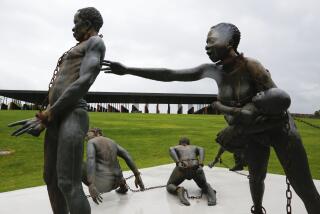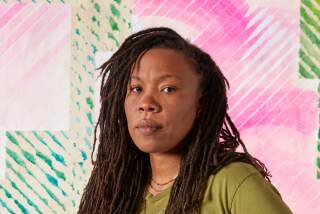How we got the story of Ellen Garrison Jackson Clark and her courageous, unsung life
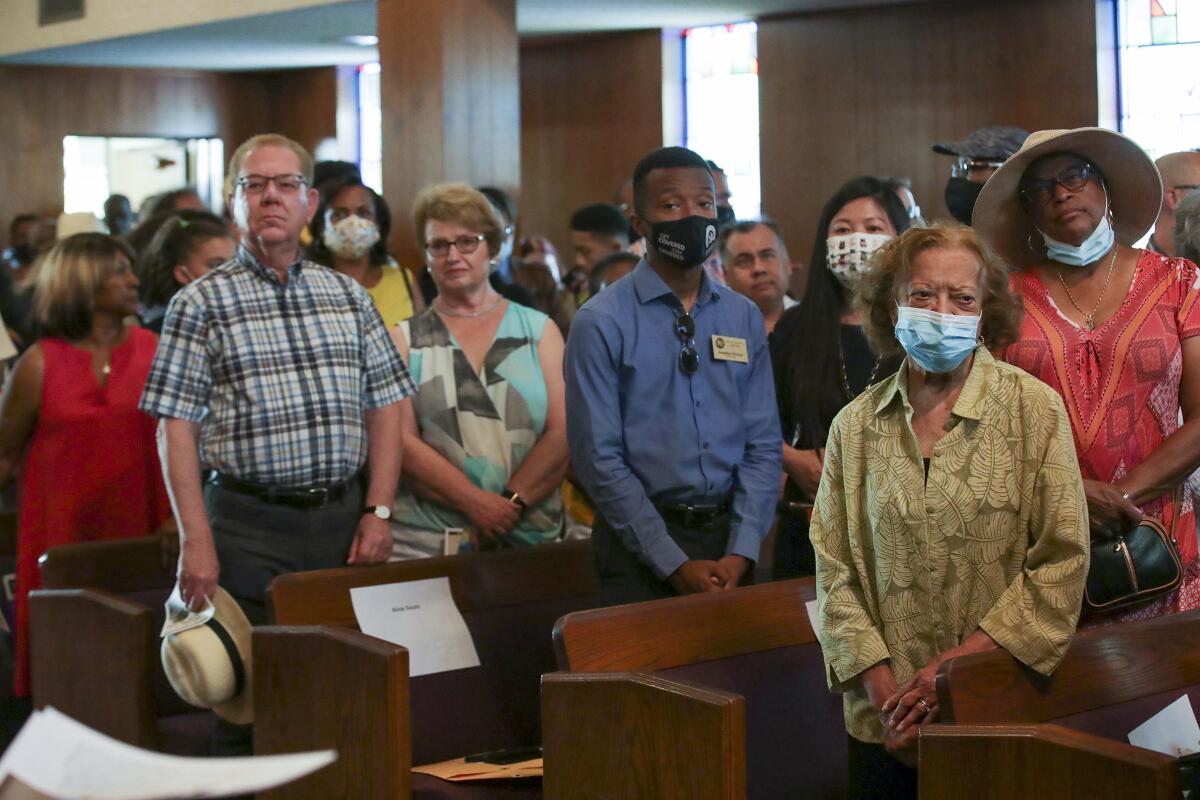
- Share via
Sometimes the best stories come from tiny, easy-to-miss tidbits in local event calendars.
Such was the case for the Altadena Historical Society’s Juneteenth ceremony to honor the courageous but little-known life of teacher and activist Ellen Garrison Jackson Clark. She was a Black woman born free in Concord, Mass., in 1823, and she spent most of her life helping formerly enslaved people learn how to read and write.
I stumbled on her story late in May while compiling a list of Juneteenth events.
Ellen Garrison Jackson Clark, the daughter of a runaway slave, was a 19th century Rosa Parks, an early civil rights activist whose work was largely forgotten. Then historians discovered she was buried in an unmarked grave in Altadena.
I almost didn’t see the entry for the Altadena Historical Society’s celebration of life for Clark on Juneteenth. The information was scant and raised more questions than it answered:
“Please join the Altadena Historical Society in celebrating the extraordinary legacy of Ellen Garrison Clark, a Black female civil rights activist and educator... Join us as we celebrate her life and lay a marker on her grave so that she will not be forgotten. The marker was made possible by generous contributions from community members.”
Once I began unraveling her story I learned that her civil rights work — at least, the work we know about — had nothing to do with California. Her work was in Massachusetts, where she grew up, and Virginia, Maryland, North Carolina and Kansas, where she taught for nearly 50 years.
We know almost nothing about her time in Los Angeles. It appears she and her husband, Harvey Clark, arrived less than two years before she died, and we don’t know the state of her health. But if she was well enough, it would have been out of character for her not to work, since she was teaching and agitating for civil rights from the time she was a teenager in Concord.
Still, it’s pretty astounding that we know the details we do, since women had little legal standing in the 19th century and rarely had careers.
In Clark’s case, it took people all over the country, often working independently, to put together the details of her life, aided considerably by data that had only recently been digitized. Here’s a sampling of those involved:
—The Robbins House Museum in Concord focused on tracking Clark’s family, starting with her maternal grandfather, Caesar Robbins, an enslaved man who earned his freedom by fighting against the British in the American Revolution.
—Historian Robert Gross, who found more than 100 letters and school reports written by Clark in the Amistad Archives for the American Missionary Association in New Orleans.
—John Hannigan, curator for the Massachusetts Archives, who researched the Robbins’ family history while he was a graduate student at Brandeis University. He was also married with children and working a job, so he’s only now completed his doctorate, but he’s kept researching Clark’s story because he couldn’t look away. “She was electric. It was hard not to get caught up in her passion.”
—Savannah State University Professor Christina Lepore Davis, who featured Clark in her dissertation, “The Collective Identities of Women Teachers in Black Schools in the Post-Bellum South” after finding her in the Freedmen’s Teacher Project database created by her mentor, University of Georgia Professor Ron Butchart, who compiled information about some 11,600 teachers of freed people in the South between 1862 and 1876 (a database that, alas, is not currently available online).
—Barton County (Kansas) Historical Society researcher Karen Neuforth, who died in March. Robbins House co-founder Liz Clayton recalls Neuforth triumphantly finding the deed that showed Harvey Clark lived in Los Angeles County when he sold his homestead in 1892 — information that led Hannigan to discover Clark had died in Pasadena and was buried in Altadena.
—Barbara Brackman, a quilt historian based in Kansas, who stumbled on Clark’s story while she was researching Civil War-era quilters in Concord, Mass., and called her sister Jane Brackman, a longtime member of the Altadena Historical Society, to tell her that this remarkable woman was buried in their midst.
The more I learn about Clark, the more frustrated I am by how little we actually know — not even what she looked like. (The photo on the Robbins House website is a “representation” of what a woman of Clark’s standing would have looked like). “Photos of Ellen are the Holy Grail,” said Hannigan. “There probably is one ... from all those school classrooms. We just haven’t found it yet.”
We do know that she was 5-foot-2 — because it was written on the passport she got in 1854 when she was 31. The passport, signed by Concord Judge Ebenezer Hoar, allowed for travel to Virginia and other states, but we don’t know why she was traveling or where.
Yet as the details emerged, I’ve come to see Clark’s story as a new data point in the surreal, ongoing debate about what really happened in our country’s past. Clark’s matter-of-fact descriptions of the verbal and physical assaults she endured in predominately white Southern communities are difficult to read, but that shouldn’t make us doubt them, says historian Davis.
“In America, we look to history to make us feel good, but history should not be a feel-good endeavor,” Davis said. “The tragic violence of slavery is part of who we are as a country and the idea it’s too troubling to talk about is just denial... People are just saying, ‘Let’s see what happened.’”
So look at you Ellen Garrison Jackson Clark — dead 129 years but still staring down injustice.
More to Read
Sign up for The Wild
We’ll help you find the best places to hike, bike and run, as well as the perfect silent spots for meditation and yoga.
You may occasionally receive promotional content from the Los Angeles Times.
